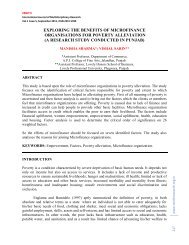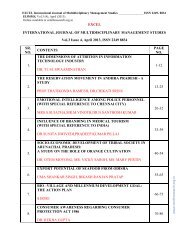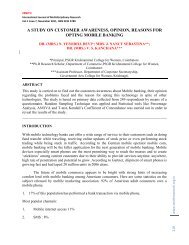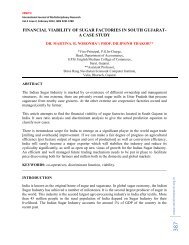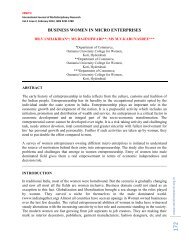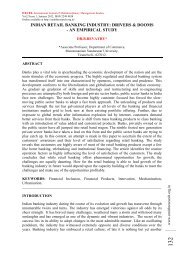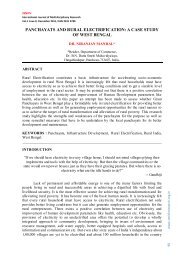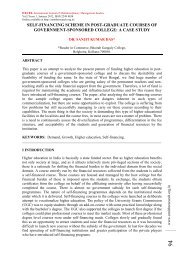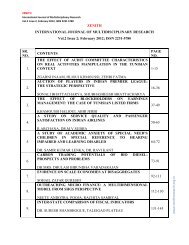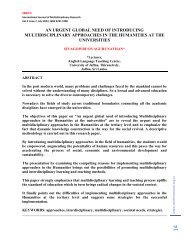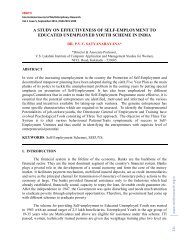ZIJBEMR MARCH 2012 ISSUE COMPLETE.pdf - zenith ...
ZIJBEMR MARCH 2012 ISSUE COMPLETE.pdf - zenith ...
ZIJBEMR MARCH 2012 ISSUE COMPLETE.pdf - zenith ...
Create successful ePaper yourself
Turn your PDF publications into a flip-book with our unique Google optimized e-Paper software.
16www.<strong>zenith</strong>research.org.inZENITH International Journal of Business Economics & Management ResearchVol.2 Issue 3, March <strong>2012</strong>, ISSN 2249 8826Online available at http://<strong>zenith</strong>research.org.in/very few resources, geared down to information, potentially relevant for better strategic decisionmaking (choice of markets, contacts) and a reduction in uncertainty management SMEs.Another use is noticed in SMEs using ICT to create „link‟ and „proximity‟ ICT will be usedto reinforce strong relational skills. It wills then guide and/or advice prospects, customers, andforeign distributors. I am then in a service logic „remote‟ that will enrich, reinforce the strategieschosen niche (Leo and Philippe, 2006) and deter companies only talk about prices. The use ofICT, including Internet and web, provide strategic advantages and operational management forSMEs such as greater integration of internal and external processes, closer relationships withcustomers and other business partners , access to richer information improving decision-makingand better access to external resources (Raymond et al. 2005). Tatoglu and Kula (2003) adds tothese advantages the direct link with customers, suppliers and distributors, as well as the fact thattransactions are facilitated, even in a context of international activities in which the simultaneousphysical presence of buyers and sellers is not necessarily required. ICT via e-mail, also appear asa tool to strengthen trade relations (Lee and Jang, 1998, Madrid, 2002), a means, via the website,to increase the international visibility (Houghton et Winklhoffer, 2004; Sgobbi and Piscitello,2004). These technologies can also support an electronic marketing, allowing a reduction ofdirect costs of access to international markets (Brynjolfsson and Smith, 1999; Tatoglu and Kula,2003). Meanwhile, other researchers point to a gap between the technological project and usesrecorded (Orlikowski, 1996, and Gadille Irribarne 2000). If indeed the use of the Internet as ameans of access to information seems to be generalised (OECD, 2000), many field investigationsshow that it is probably necessary to dig ICT exports and the relationship (and Sgobbi Piscitello,2004; and Winklhoffer Houghton, 2004). These technologies are the subject of investments madeoutside the desired rationality, their uses are more or less integrated in the operation, possiblyaffecting a small part of business functions, creating islands and too isolated that the overallperformance is improved. The question of the effectiveness of ICT remains unanswered,especially vis-à-vis the international business. If these technologies are tools that SMEs can taketo find a close relationship with the players remote, they cannot, as suggested by Giddens (1994),envisaged exclusively, without attention to maintaining or the creation of a trust with „the othersaway‟. Maintenance of practices before the use of ICT (face to face meetings, for example) is, inthis respect, important (Sgobbi Piscitello, 2004).4. THE INFLUENCE OF THE BACKGROUND AND OBJECTIVES OF THE LEADEROF ICT ADOPTIONResearchers have often shown the influence of attitude and profile of the Chief, on thestrategic direction of the company and its organisation. The assumption can be made of the sameinfluence on the mode of integration and appropriation of ICTs. The experience and training ofthis officer are the factors inhibiting the use of technology (and Mykytyn Riemenschneider,2000). Moreover, as suggested by Raymond et al. (2005), experience and a high level ofeducation should raise the head of the SMEs of the importance of using IT to the extent that theycan promote information management and uncertainty in the context of international affairs.This favourable attitude toward IT has been studied by Jeffcoate et al. (2002) suggest that,in a prescriptive model, the leader of SMEs proactive and focusing on high growth targets shouldbe more to use these technologies than others. In addition, this leader will be more oriented



